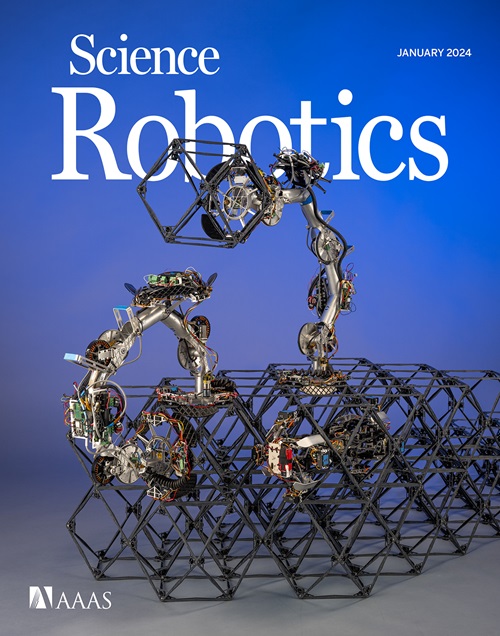Magnetically actuated dexterous tools for minimally invasive operation inside the brain
IF 27.5
1区 计算机科学
Q1 ROBOTICS
引用次数: 0
Abstract
Operating in the brain for deep-seated tumors or surgical targets for epilepsy is technically demanding and normally requires a large craniotomy with its attendant risk and morbidity. Neuroendoscopic surgery has the potential to reduce risk and morbidity by permitting surgical access through a small incision with burr hole and a narrow corridor through the brain. However, current endoscopic neurosurgical tools are straight and rigid and lack dexterity, hindering their adoption for neuroendoscopic procedures. We propose a class of robotic neurosurgical tools that have magnetically actuated wristed end effectors small enough to fit through a neuroendoscope working channel. The tools were less than 3.2 millimeters in overall diameter and contained embedded permanent magnets that allowed wireless actuation with magnetic fields. Three magnetic tools are presented: a two–degrees-of-freedom (DoFs) wristed gripper, a one-DoF pivoting scalpel, and a one-DoF twisted string–actuated forceps. This work evaluated the feasibility of these tools for completing minimally invasive neurosurgical resection and cutting tasks. Experimental tests on a silicone brain phantom showed that the tools could reach the ventricle area for simulated tumor removal and access a section of the corpus callosotomy for a simulated tissue-severing procedure in epilepsy treatment. Integration of the magnetic end effectors with a concentric tube robot as a hybrid steerable surgical robotic system enabled in vivo experiments on piglets. These experiments show that wireless magnetic tools could perform essential neurosurgical tasks, including gripping, cutting, and biopsy on living brain tissue, suggesting their potential for clinical applications.
用于脑内微创手术的磁驱动灵巧工具
对深部肿瘤或癫痫的手术目标进行脑部手术在技术上要求很高,通常需要进行大开颅手术,并伴有风险和发病率。神经内窥镜手术可以通过一个带有毛刺孔的小切口和一个狭窄的脑部通道进行手术,从而有可能降低风险和发病率。然而,目前的内窥镜神经外科工具是直的,刚性的,缺乏灵活性,阻碍了它们在神经内窥镜手术中的应用。我们提出了一类机器人神经外科工具,它具有足够小的磁力驱动腕式末端执行器,可以通过神经内窥镜工作通道。该工具的总直径小于3.2毫米,内置永磁体,可以通过磁场无线驱动。介绍了三种磁性工具:二自由度腕式夹持器、一自由度旋转手术刀和一自由度扭弦驱动钳。这项工作评估了这些工具完成微创神经外科切除和切割任务的可行性。在硅胶脑模型上进行的实验测试表明,这些工具可以到达脑室区域进行模拟肿瘤切除,也可以进入胼胝体切开术的一部分,进行模拟癫痫治疗中的组织切断手术。将磁性末端执行器与同心管机器人集成为一种混合可操纵手术机器人系统,实现了仔猪体内实验。这些实验表明,无线磁性工具可以执行基本的神经外科任务,包括抓握、切割和活体脑组织活检,这表明它们具有临床应用的潜力。
本文章由计算机程序翻译,如有差异,请以英文原文为准。
求助全文
约1分钟内获得全文
求助全文
来源期刊

Science Robotics
Mathematics-Control and Optimization
CiteScore
30.60
自引率
2.80%
发文量
83
期刊介绍:
Science Robotics publishes original, peer-reviewed, science- or engineering-based research articles that advance the field of robotics. The journal also features editor-commissioned Reviews. An international team of academic editors holds Science Robotics articles to the same high-quality standard that is the hallmark of the Science family of journals.
Sub-topics include: actuators, advanced materials, artificial Intelligence, autonomous vehicles, bio-inspired design, exoskeletons, fabrication, field robotics, human-robot interaction, humanoids, industrial robotics, kinematics, machine learning, material science, medical technology, motion planning and control, micro- and nano-robotics, multi-robot control, sensors, service robotics, social and ethical issues, soft robotics, and space, planetary and undersea exploration.
 求助内容:
求助内容: 应助结果提醒方式:
应助结果提醒方式:


